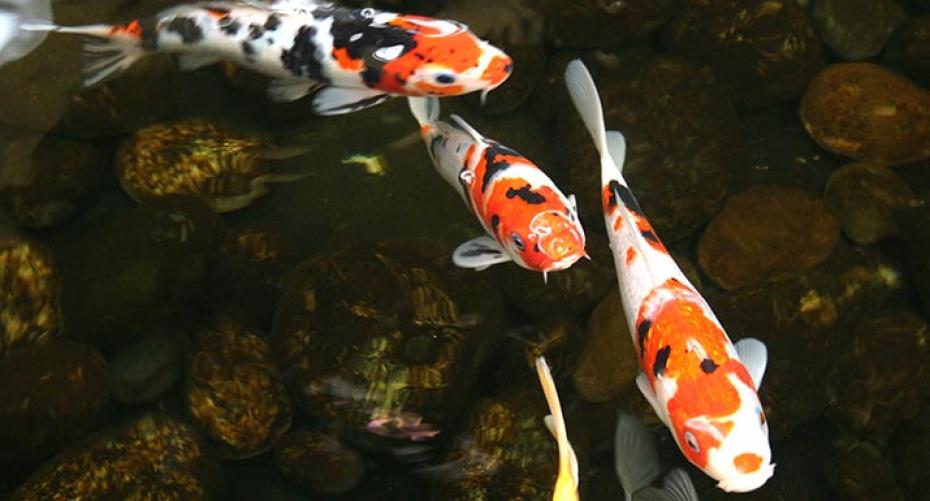There is still time to spruce up your pond for the summer season. Follow our simple 6 point guide to get the most from your garden pond this summer.
1. Cleaning
Check the bottom of the pond and waterfalls for leaves and other large debris then carefully remove using a net. If there is other organic matter or silt on the bottom this can be removed easily by using a Pondi Pond Vacuum which makes pond cleaning easy.
 2. Repairing
2. Repairing
Check the pond for leaks. If the water level has stayed constant in a spell of dry weather over winter then it should be alright. If the water level has fluctuated then there is water loss somewhere. If you have a leak in your pond the water will drop to that level. Don’t forget to check any waterfalls as well.
3. Equipment
Remove the pump from the pond, open the housing, remove the impellor and clean it, remembering to clean inside the impellor thoroughly.
If you did not clean your filter before turning off your system for winter now is the time to do it. Clean all the foams in buckets of pond water. If your filter has flocur (looks a bit like plastic hose) in the bottom consider changing it to a superior media such as Kaldness K1 as this will increase filtering capacity greatly. Don’t forget that your fish are growing all the time. Now is a good time to introduce filter bacteria such as Pure Pond to give your filter a boost for the coming season.
 If you have an ultra violet clarifier the lamp or UV tube requires changing even if it still works, as its effectiveness will be greatly diminished. The quartz sleeve in which it sits will need to be removed and cleaned as this gets coated with lime scale and silt. Alternatively use a UV Booster Treatment which breaks down the limescale and helps clean the quartz sleeve. Finally check all hoses and connectors for leaks including all clips to ensure they are secure.
If you have an ultra violet clarifier the lamp or UV tube requires changing even if it still works, as its effectiveness will be greatly diminished. The quartz sleeve in which it sits will need to be removed and cleaned as this gets coated with lime scale and silt. Alternatively use a UV Booster Treatment which breaks down the limescale and helps clean the quartz sleeve. Finally check all hoses and connectors for leaks including all clips to ensure they are secure.
4. Plants
 Spring is the best time to buy new plants and check your existing marginal and deep water plants but this can be done in summer too. Trim off any dead or dying leaves and divide the plants if necessary. Trim any excess roots before transplanting into larger baskets with fresh aquatic compost and a slow release food tablet such as Aquafeed.
Spring is the best time to buy new plants and check your existing marginal and deep water plants but this can be done in summer too. Trim off any dead or dying leaves and divide the plants if necessary. Trim any excess roots before transplanting into larger baskets with fresh aquatic compost and a slow release food tablet such as Aquafeed.
5. Water
Now is the time to test the water quality. Ammonia, Nitrite, Nitrate and pH levels should be checked. Any problems can be rectified by carrying out a partial water change, the easiest way to do this is to trickle water in & allow your pond to overflow. Ideally rainwater collected in a waterbutt is best for this as it contains fewer nutrients than tapwater & so is less likely to cause an algal bloom or encourage blanketweed. The other alternative is to wait for rain but if you have to use tapwater & it is high in chlorine it is best to use a water conditioner or an inline Detoxifying Unit to remove the chlorine and chloramine. Carry out regular water testing to ensure your filter is coping with the quantity of food being fed to your fish.
6. Feeding
 Start feeding when the water temperature rises above 6°C. At temperatures between 6-12°C feed once a day with a wheat germ based food. Above 10°C a staple food can be fed twice a day and above 15°C a growth or high protein food can be fed up to 4 times a day. An automatic fish feeder (shown) can be used if you wish which also comes in handy when you go away on holiday. Check your water temperature regularly especially during the cooler months using a pond thermometer, they are an invaluable aid. Don’t forget to remove any uneaten food after 5-10 minutes as this may cause water quality issues. If there is food left uneaten regularly, adjust the amount of food being offered.
Start feeding when the water temperature rises above 6°C. At temperatures between 6-12°C feed once a day with a wheat germ based food. Above 10°C a staple food can be fed twice a day and above 15°C a growth or high protein food can be fed up to 4 times a day. An automatic fish feeder (shown) can be used if you wish which also comes in handy when you go away on holiday. Check your water temperature regularly especially during the cooler months using a pond thermometer, they are an invaluable aid. Don’t forget to remove any uneaten food after 5-10 minutes as this may cause water quality issues. If there is food left uneaten regularly, adjust the amount of food being offered.
When the summer is over, clean out your filter/UV system and store it away so it will not be damaged by frost. To keep a small hole free from ice in your pond this coming winter why not invest in a pond heater?


